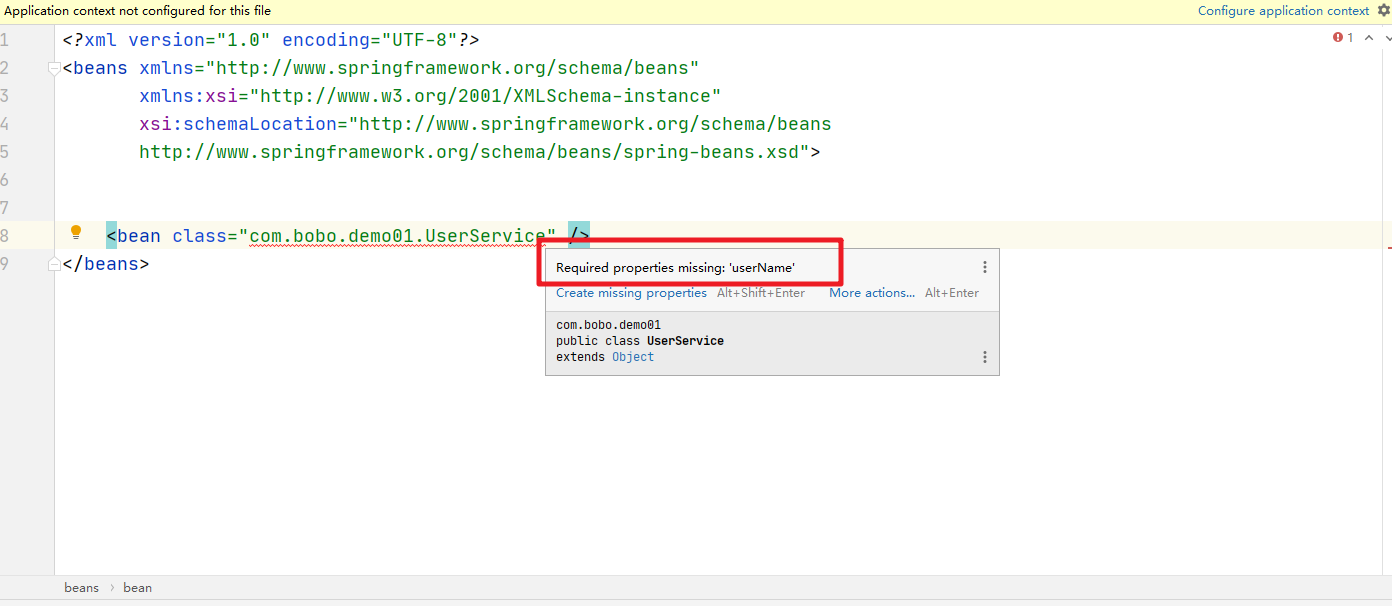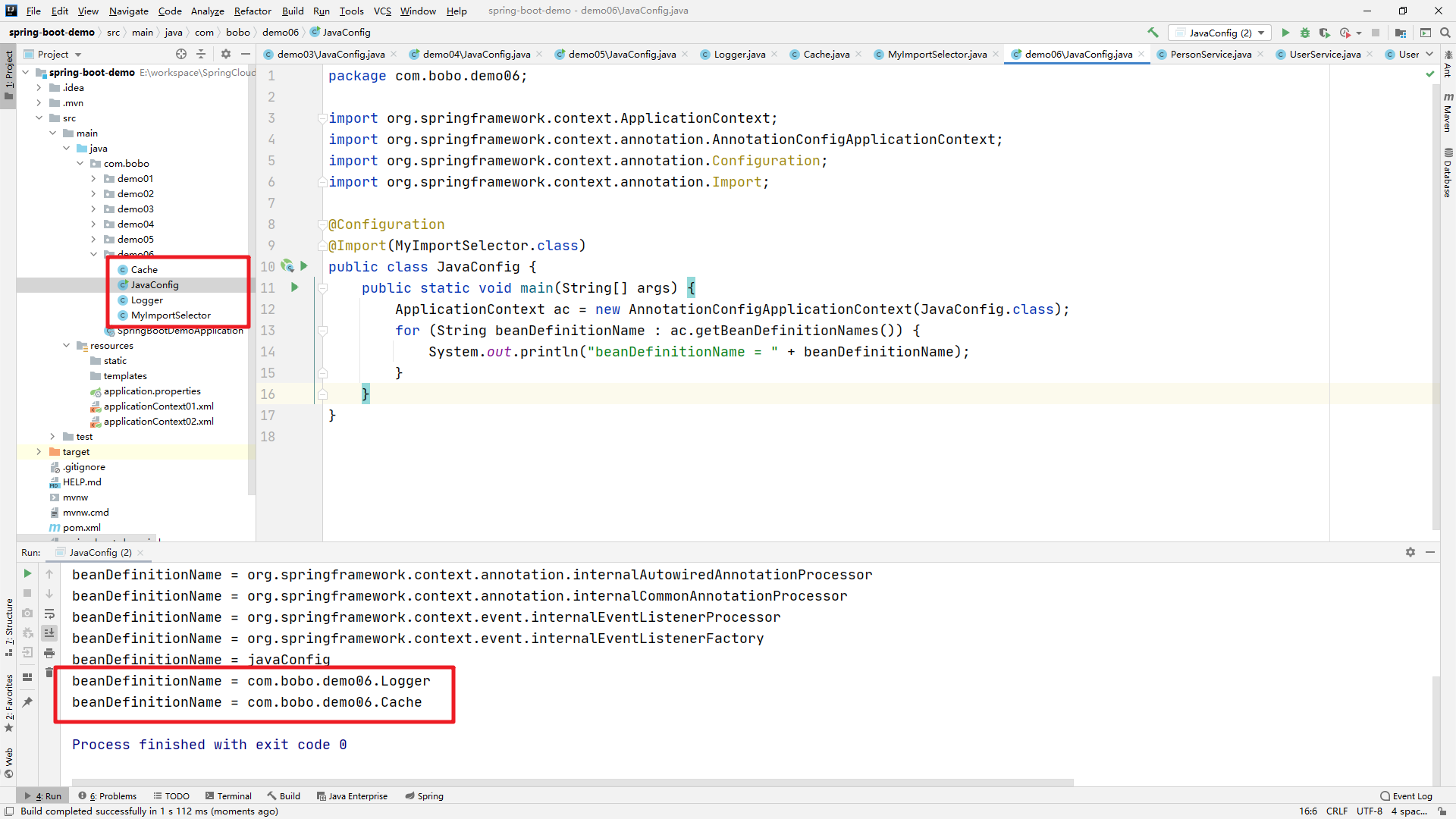重新认识SpringBoot
1.Spring注解编程的发展过程
为了更好的掌握SpringBoot的内容,我需要先给大家介绍下Spring注解编程的发展过程,通过该过程的演变能够让大家更加清楚SpringBoot的由来。

1.1 Spring 1.x
2004年3月24日,Spring1.0 正式发布,提供了IoC,AOP及XML配置的方式。
在Spring1.x版本中提供的是纯XML配置的方式,也就是在该版本中我们必须要提供xml的配置文件,在该文件中我们通过 <bean> 标签来配置需要被IoC容器管理的Bean。
<?xml version="1.0" encoding="UTF-8"?> <beans xmlns="http://www.springframework.org/schema/beans" xmlns:xsi="http://www.w3.org/2001/XMLSchema-instance" xsi:schemaLocation="http://www.springframework.org/schema/beans http://www.springframework.org/schema/beans/spring-beans.xsd"> <bean class="com.bobo.demo01.UserService" /> </beans>
调试代码
public static void main(String[] args) { ApplicationContext ac = new FileSystemXmlApplicationContext("classpath:applicationContext01.xml"); System.out.println("ac.getBean(UserService.class) = " + ac.getBean(UserService.class)); }
输出结果

在Spring1.2版本的时候提供了@Transaction (org.springframework.transaction.annotation )注解。简化了事务的操作.

1.2 Spring 2.x
在2006年10月3日 Spring2.0问世了,在2.x版本中,比较重要的特点是增加了很多注解
Spring 2.5之前
在2.5版本之前新增的有 @Required @Repository @Aspect,同时也扩展了XML的配置能力,提供了第三方的扩展标签,比如 <dubbo>
@Required
如果你在某个java类的某个set方法上使用了该注释,那么该set方法对应的属性在xml配置文件中必须被设置,否则就会报错!!!
public class UserService { private String userName; public String getUserName() { return userName; } @Required public void setUserName(String userName) { this.userName = userName; } }
如果在xml文件中我们不设置对应的属性就会给出错误的提示。

设置好属性后就没有了错误提示了

源码中可以看到 @Required从2.0开始提供

@Repository
@Repository 对应数据访问层Bean.这个注解在Spring2.0版本就提供的有哦,大家可能没有想到。

@Aspect
@Aspect是AOP相关的一个注解,用来标识配置类。
Spring2.5 之后
在2007年11月19日,Spring更新到了2.5版本,新增了很多常用注解,大大的简化配置操作。
| 注解 | 说明 |
|---|---|
| @Autowired | 依赖注入 |
| @Qualifier | 配置@Autowired注解使用 |
| @Component | 声明组件 |
| @Service | 声明业务层组件 |
| @Controller | 声明控制层组件 |
| @RequestMapping | 声明请求对应的处理方法 |
在这些注解的作用下,我们可以不用在xml文件中去注册没有bean,这时我们只需要指定扫码路径,然后在对应的Bean头部添加相关的注解即可,这大大的简化了我们的配置及维护工作。案例如下:
我们在配置文件中只需要配置扫码路径即可:
<?xml version="1.0" encoding="UTF-8"?> <beans xmlns="http://www.springframework.org/schema/beans" xmlns:xsi="http://www.w3.org/2001/XMLSchema-instance" xmlns:context="http://www.springframework.org/schema/context" xsi:schemaLocation="http://www.springframework.org/schema/beans http://www.springframework.org/schema/beans/spring-beans.xsd http://www.springframework.org/schema/context http://www.springframework.org/schema/context/spring-context.xsd"> <context:component-scan base-package="com.bobo" /> </beans>
持久层代码:
@Repository public class UserDao { public void query(){ System.out.println("dao query ..." ); } } 业务逻辑层代码 @Service public class UserService { @Autowired private UserDao dao; public void query(){ dao.query(); } } 控制层代码: @Controller public class UserController { @Autowired private UserService service; public void query(){ service.query(); } } 测试代码 public class Demo02Main { public static void main(String[] args) { ApplicationContext ac = new ClassPathXmlApplicationContext("applicationContext02.xml"); UserController acBean = ac.getBean(UserController.class); acBean.query(); } }
虽然在Spring的2.5版本提供了很多的注解,也大大的简化了我们的开发,但是任然没有摆脱XML配置驱动。
1.3 Spring 3.x
在2009年12月16日发布了Spring3.0版本,这是一个注解编程发展的里程碑版本,在该版本中全面拥抱Java5。提供了 @Configuration注解,目的就是去xml化。同时通过 @ImportResource来实现Java配置类和XML配置的混合使用来实现平稳过渡。
/** * @Configuration 标注的Java类 相当于 application.xml 配置文件 */ @Configuration public class JavaConfig { /** * @Bean 注解 标注的方法就相当于 <bean></bean> 标签 也是 Spring3.0 提供的注解 * @return */ @Bean public UserService userService(){ return new UserService(); } }
在Spring3.1 版之前配置扫描路径我们还只能在 XML 配置文件中通过 component-scan 标签来实现,在3.1之前还不能够完全实现去XML配置,在3.1 版本到来的时候,提供了一个 @ComponentScan注解,该注解的作用是替换掉 component-scan标签,是注解编程很大的进步,也是Spring实现无配置话的坚实基础。
@ComponentScan
@ComponentScan的作用是指定扫码路径,用来替代在XML中的 <component-scan>标签,默认的扫码路径是当前注解标注的类所在的包及其子包。
定义UserService @Service public class UserService { } 创建对于的Java配置类 @Configuration @ComponentScan public class JavaConfig { public static void main(String[] args) { ApplicationContext ac = new AnnotationConfigApplicationContext(JavaConfig.class); System.out.println("ac.getBean(UserService.class) = " + ac.getBean(UserService.class)); } }
输出的结果

当然也可以指定特定的扫描路径
@Configuration // 指定特定的扫描路径 @ComponentScan(value = {"com.bobo.demo04"}) public class JavaConfig { public static void main(String[] args) { ApplicationContext ac = new AnnotationConfigApplicationContext(JavaConfig.class); System.out.println("ac.getBean(UserService.class) = " + ac.getBean(UserService.class)); } }
@Import
@Import注解只能用在类上,作用是快速的将实例导入到Spring的IoC容器中,将实例导入到IoC容器中的方式有很多种,比如 @Bean注解,@Import注解可以用于导入第三方包。具体的使用方式有三种。
静态导入
静态导入的方式是直接将我们需要导入到IoC容器中的对象类型直接添加进去即可。

这种方式的好处是简单,直接,但是缺点是如果要导入的比较多,则不太方便,而且也不灵活。
ImportSelector
@Import注解中我们也可以添加一个实现了 ImportSelector接口的类型,这时不会将该类型导入IoC容器中,而是会调用 ImportSelector接口中定义的 selectImports方法,将该方法的返回的字符串数组的类型添加到容器中。
定义两个业务类 public class Cache { } public class Logger { } 定义ImportSelector接口的实现,方法返回的是需要添加到IoC容器中的对象对应的类型的全类路径的字符串数组,我们可以根据不同的业务需求而导入不同的类型,会更加的灵活些。 public class MyImportSelector implements ImportSelector { @Override public String[] selectImports(AnnotationMetadata importingClassMetadata) { return new String[]{Logger.class.getName(),Cache.class.getName()}; } } 导入测试案例 @Configuration @Import(MyImportSelector.class) public class JavaConfig { public static void main(String[] args) { ApplicationContext ac = new AnnotationConfigApplicationContext(JavaConfig.class); for (String beanDefinitionName : ac.getBeanDefinitionNames()) { System.out.println("beanDefinitionName = " + beanDefinitionName); } } }
输出结果:

ImportBeanDefinitionRegistrar
除了上面所介绍的ImportSelector方式灵活导入以外还提供了 ImportBeanDefinitionRegistrar 接口,也可以实现,相比 ImportSelector 接口的方式,ImportBeanDefinitionRegistrar 的方式是直接在定义的方法中提供了 BeanDefinitionRegistry ,自己在方法中实现注册。
public class MyImportBeanDefinitionRegistrar implements ImportBeanDefinitionRegistrar { @Override public void registerBeanDefinitions(AnnotationMetadata importingClassMetadata, BeanDefinitionRegistry registry) { // 将需要注册的对象封装为 RootBeanDefinition 对象 00cache = new RootBeanDefinition(Cache.class); registry.registerBeanDefinition("cache",cache); RootBeanDefinition logger = new RootBeanDefinition(Logger.class); registry.registerBeanDefinition("logger",logger); } } 测试代码 @Configuration @Import(MyImportBeanDefinitionRegistrar.class) public class JavaConfig { public static void main(String[] args) { ApplicationContext ac = new AnnotationConfigApplicationContext(JavaConfig.class); for (String beanDefinitionName : ac.getBeanDefinitionNames()) { System.out.println("beanDefinitionName = " + beanDefinitionName); } } }
输出结果

@EnableXXX
@Enable模块驱动,其实是在系统中我们先开发好各个功能独立的模块,比如 Web MVC 模块, AspectJ代理模块,Caching模块等。

案例说明,先定义好功能模块 /** * 定义一个Java配置类 */ @Configuration public class HelloWorldConfiguration { @Bean public String helloWorld(){ return "Hello World"; } } 然后定义@Enable注解 /** * 定义@Enable注解 * 在该注解中通过 @Import 注解导入我们自定义的模块,使之生效。 */ @Target(ElementType.TYPE) @Retention(RetentionPolicy.RUNTIME) @Documented @Import(HelloWorldConfiguration.class) public @interface EnableHelloWorld { } 测试代码 @Configuration // 加载 自定义 模块 @EnableHelloWorld public class JavaMian { public static void main(String[] args) { ApplicationContext ac = new AnnotationConfigApplicationContext(JavaMian.class); String helloWorld = ac.getBean("helloWorld", String.class); System.out.println("helloWorld = " + helloWorld); } }
效果

1.4 Spring 4.x
2013年11月1 日更新的Spring 4.0 ,完全支持Java8.这是一个注解完善的时代,提供的核心注解是@Conditional条件注解。@Conditional 注解的作用是按照一定的条件进行判断,满足条件就给容器注册Bean实例。
@Conditional的定义为: // 该注解可以在 类和方法中使用 @Target({ElementType.TYPE, ElementType.METHOD}) @Retention(RetentionPolicy.RUNTIME) @Documented public @interface Conditional { /** * 注解中添加的类型必须是 实现了 Condition 接口的类型 */ Class<? extends Condition>[] value(); } Condition是个接口,需要实现matches方法,返回true则注入bean,false则不注入。 案例讲解: /** * 定义一个 Condition 接口的是实现 */ public class MyCondition implements Condition { @Override public boolean matches(ConditionContext context, AnnotatedTypeMetadata metadata) { return false; // 默认返回false } } 创建Java配置类 @Configuration public class JavaConfig { @Bean // 条件注解,添加的类型必须是 实现了 Condition 接口的类型 // MyCondition的 matches 方法返回true 则注入,返回false 则不注入 @Conditional(MyCondition.class) public StudentService studentService(){ return new StudentService(); } public static void main(String[] args) { ApplicationContext ac = new AnnotationConfigApplicationContext(JavaConfig.class); for (String beanDefinitionName : ac.getBeanDefinitionNames()) { System.out.println("beanDefinitionName = " + beanDefinitionName); } } }
测试:

但是将 matchs方法的返回结果设置为 true 则效果不同

所以@Conditional的作用就是给我们提供了对象导入IoC容器的条件机制,这也是SpringBoot中的自动装配的核心关键。当然在4.x还提供一些其他的注解支持,比如 @EventListener,作为ApplicationListener接口编程的第二选择,@AliasFor解除注解派生的时候冲突限制。@CrossOrigin作为浏览器跨域资源的解决方案。
1.5 Spring 5.x
2017年9月28日,Spring来到了5.0版本。5.0同时也是SpringBoot2.0的底层。注解驱动的性能提升方面不是很明显。在Spring Boot应用场景中,大量使用@ComponentScan扫描,导致Spring模式的注解解析时间耗时增大,因此,5.0时代引入*@Indexed*,为Spring模式注解添加索引。
当我们在项目中使用了 @Indexed之后,编译打包的时候会在项目中自动生成 META-INT/spring.components文件。当Spring应用上下文执行 ComponentScan扫描时,META-INT/spring.components将会被 CandidateComponentsIndexLoader 读取并加载,转换为 CandidateComponentsIndex对象,这样的话 @ComponentScan不在扫描指定的package,而是读取 CandidateComponentsIndex对象,从而达到提升性能的目的。
<dependency>
<groupId>org.springframework</groupId>
<artifactId>spring-context-indexer</artifactId>
</dependency>使用@Indexed注解


2. 什么是SPI
为什么要讲SPI呢?因为在SpringBoot的自动装配中其实有使用到SPI机制,所以掌握了这部分对于SpringBoot的学习还是很有帮助的。
SPI ,全称为 Service Provider Interface,是一种服务发现机制。它通过在ClassPath路径下的META-INF/services文件夹查找文件,自动加载文件里所定义的类。这一机制为很多框架扩展提供了可能,比如在Dubbo、JDBC中都使用到了SPI机制。我们先通过一个很简单的例子来看下它是怎么用的。
SPI规范:在ClassPath路径下的META-INF/services文件夹下创建文件,文件名称是:接口的全类路径的名称,内容是:实现这个接口的实现类的全类路径。
SPI 全称为 (Service Provider Interface) ,是JDK内置的一种服务提供发现机制。SPI是一种动态替换发现的机制, 比如有个接口,想运行时动态的给它添加实现,你只需要添加一个实现。我们经常遇到的就是java.sql.Driver接口,其他不同厂商可以针对同一接口做出不同的实现,mysql和postgresql都有不同的实现提供给用户,而Java的SPI机制可以为某个接口寻找服务实现。

如上图所示,接口对应的抽象SPI接口;实现方实现SPI接口;调用方依赖SPI接口。
SPI接口的定义在调用方,在概念上更依赖调用方;组织上位于调用方所在的包中,实现位于独立的包中。
当服务的提供者提供了一种接口的实现之后,需要在classpath下的META-INF/services/目录里创建一个以服务接口命名的文件,这个文件里的内容就是这个接口的具体的实现类。当其他的程序需要这个服务的时候,就可以通过查找这个jar包(一般都是以jar包做依赖)的META-INF/services/中的配置文件,配置文件中有接口的具体实现类名,可以根据这个类名进行加载实例化,就可以使用该服务了。JDK中查找服务实现的工具类是:java.util.ServiceLoader。
参考:springboot 之SPI机制详解(一)_weixin_35688430的博客-CSDN博客_springboot+spi
案例介绍
先定义接口项目

然后创建一个扩展的实现,先导入上面接口项目的依赖
<dependencies> <dependency> <groupId>com.bobo</groupId> <artifactId>JavaSPIBase</artifactId> <version>1.0-SNAPSHOT</version> </dependency> </dependencies>
然后创建接口的实现
/** * SPI:MySQL对于 baseURL 的一种实现 */ public class MySQLData implements BaseData { @Override public void baseURL() { System.out.println("mysql 的扩展实现...."); } }
然后在resources目录下创建 META-INF/services 目录,然后在目录中创建一个文件,名称必须是定义的接口的全类路径名称。然后在文件中写上接口的实现类的全类路径名称。

同样的再创建一个案例

然后在测试的项目中测试
public static void main(String[] args) { ServiceLoader<BaseData> providers = ServiceLoader.load(BaseData.class); Iterator<BaseData> iterator = providers.iterator(); while(iterator.hasNext()){ BaseData next = iterator.next(); next.baseURL(); } }
根据不同的导入,执行的逻辑会有不同


源码查看
ServiceLoader
首先来看下ServiceLoader的类结构
// 配置文件的路径 private static final String PREFIX = "META-INF/services/"; // 加载的服务 类或者接口 private final Class<S> service; // 类加载器 private final ClassLoader loader; // 访问权限的上下文对象 private final AccessControlContext acc; // 保存已经加载的服务类 private LinkedHashMap<String,S> providers = new LinkedHashMap<>(); // 内部类,真正加载服务类 private LazyIterator lookupIterator;
load
load方法创建了一些属性,重要的是实例化了内部类,LazyIterator。
public final class ServiceLoader<S> implements Iterable<S> private ServiceLoader(Class<S> svc, ClassLoader cl) { //要加载的接口 service = Objects.requireNonNull(svc, "Service interface cannot be null"); //类加载器 loader = (cl == null) ? ClassLoader.getSystemClassLoader() : cl; //访问控制器 acc = (System.getSecurityManager() != null) ? AccessController.getContext() : null; reload(); } public void reload() { //先清空 providers.clear(); //实例化内部类 LazyIterator lookupIterator = new LazyIterator(service, loader); } }
查找实现类和创建实现类的过程,都在LazyIterator完成。当我们调用iterator.hasNext和iterator.next方法的时候,实际上调用的都是LazyIterator的相应方法。
private class LazyIterator implements Iterator<S>{ Class<S> service; ClassLoader loader; Enumeration<URL> configs = null; Iterator<String> pending = null; String nextName = null; private boolean hasNextService() { //第二次调用的时候,已经解析完成了,直接返回 if (nextName != null) { return true; } if (configs == null) { //META-INF/services/ 加上接口的全限定类名,就是文件服务类的文件 //META-INF/services/com.viewscenes.netsupervisor.spi.SPIService String fullName = PREFIX + service.getName(); //将文件路径转成URL对象 configs = loader.getResources(fullName); } while ((pending == null) || !pending.hasNext()) { //解析URL文件对象,读取内容,最后返回 pending = parse(service, configs.nextElement()); } //拿到第一个实现类的类名 nextName = pending.next(); return true; } }
创建实例对象,当然,调用next方法的时候,实际调用到的是,lookupIterator.nextService。它通过反射的方式,创建实现类的实例并返回。
private class LazyIterator implements Iterator<S>{ private S nextService() { //全限定类名 String cn = nextName; nextName = null; //创建类的Class对象 Class<?> c = Class.forName(cn, false, loader); //通过newInstance实例化 S p = service.cast(c.newInstance()); //放入集合,返回实例 providers.put(cn, p); return p; } }
看到这儿,我想已经很清楚了。获取到类的实例,我们自然就可以对它为所欲为了!




